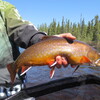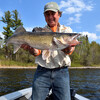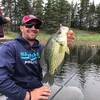
How To Target Black Crappies (Part 1)

One of the most daunting tasks facing ice anglers, who target the myriad waters spread across Northern Ontario's vast fishing hinterland, is quite simply the unfathomable supply. I mean, with more than 400,000 lakes and two-fifths of all the fresh water on Earth, where do you start looking?
It is the subject I broached with my good friend Pete Garnier when I met up with him at the Toronto Spring Fishing Show. Pete is one of Ontario's elite bass professionals, spending much of the open water season traipsing across the continent participating in big cast-for-cash events. Because many of the competitions are held on water bodies that he has never seen before, he has to find the fish quickly.
Not surprisingly, Garnier has been able to take the lessons he has learned from 26 years on the tournament trail and apply them to his real passion: catching black crappies in the winter time across Northern Ontario.

Pete Garnier, shown here with a beautiful black crappie, says you should always explore new waters with a feeling of excitement and adventure, rather than as a daunting task.
"Finding the fish is clearly the initial hurdle we all must face," chuckles Garnier, "and having the right mental attitude is likely your biggest asset. I've always looked at attacking new waters with a feeling of excitement and adventure, rather than as a daunting challenge. I like sniffing out potential hot-spot information online using Google Earth, the Northern Ontario Portal and apps like Navionics. So, before I leave the house, I have a game plan – an idea about the size and shape of the lake, the location of potential fishing areas and key access points.
While you can do a lot of planning in the comfort of your home, Garnier concedes that the real work begins once you arrive at your chosen Northern Ontario fishing destination.
"There's no doubt you have to do some legwork initially," says the 2012 SCFL National Classic Champion. "On a big lake like Lake Simcoe, Lake Nipissing, or along the north shore of Lake Huron, you're going to have to drill plenty of holes, so having a sharp auger like the new Ion X and good electronics are massive time-savers. I couldn't ice fish without my Vexilar X28.
"Different lakes, especially in Central and Northeastern Ontario, but right across the north, fish quite differently. On some lakes, I do extremely well concentrating on deep weed lines. Even fishing in the heart of a weed flat. In other lakes, however, I find the crappies roaming in open water aggregations, while in still others I catch them concentrated in isolated basins.
"The key is keeping an open mind and an exploratory attitude. Locating fish in the winter is no different than in the open water season. It takes a little bit of work, but for those willing to put in the effort, the rewards of chasing crappies in Northern Ontario are outstanding."

And talking about outstanding, you have to see Garnier crouched over a hole in the ice, after he locates a school of giant Ontario crappies, to believe your eyes. It is like watching Michelangelo paint the Sistine Chapel or Leonardo sketch the Mona Lisa.
"This is where the art of fishing comes into play," says Garnier. "How often have you been hammering away on fish after fish, while the majority of other anglers around you are scratching their heads? It boils down to paying attention to details, trying different bait manipulations with your rod, and judging how the fish are responding to what you're offering them."
Garnier, who is enamoured by the Angler's Choice crappie series of soft plastic dressings, says that your choice of bait is certainly part of the equation, but when you find the fish tight-lipped and inactive, what you do with it – in other words, how you present it – is even more important.
"Learning different presentations with a bait through the ice is critical," he says. "There's no right or wrong combination. You have to experiment with big rod movements, small-tight wiggles and jiggles, long pauses, short pauses and all of the different cadences in between. At the same time, you have to pay close attention to the behaviour of the fish on your sonar screen. Ultimately the crappies will tell you what they want, or more importantly, what they don't want.
Garnier – who loves to explore for crappies in the area bounded by the Kawartha Lakes and Lake Simcoe to the south, Lake Nipissing and the French River to the north, Georgian Bay to the west, and the Ottawa River to the east – says crappies can be extremely temperamental.

"Their mood changes like a chameleon at the disco," he laughs. "When they're active, it doesn't matter what you do – but that is only about 10 percent of the time at best. Catching them when they are not feeding, now that is the real challenge.
"I refer to it as 'video games on ice' – watching your electronics and paying attention to how the fish react to your bait. I think a lot of ice anglers focus too much on how they were moving their bait when they caught a crappie, but I concentrate on what I was doing when I didn't catch it. When I watch a crappie come in, look at my lure, pause and then swim away, it signals a change in the fish's activity level and tells me I need to alter my presentation."
To learn more about how Pete Garnier targets black crappies in Northern Ontario in the winter and to discover his amazing "go-to" black crappie pattern, read Part Two.
Recommended Articles

Ontario’s Top 5 Ice-Out Species

Casting for Coasters
Catching Ontario Walleye
Ontario Brook Trout
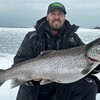
Ontario Brown Trout Fishing
Plan Your Fishing Success
Don’t Be Afraid Of Muskies
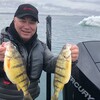
Spring Perch Fishing

10 Facts About Lake of the Woods
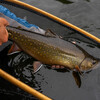
Adventures on the Nipigon River

5 Places to Shore Fish

3 Great Ontario Walleye Destinations

Long Nose Gar

Top 5 Baits for Smallmouth and Largemouth Bass
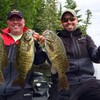
Four Seasons of Bass in Ontario
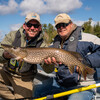
La Place Rendez-Vous on Rainy Lake
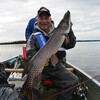
Spring Fishing Tips For Any Angler
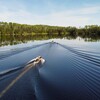
Leuenberger Air Service Is Your Ticket to Ontario's Best Fishing
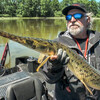
Stalking Prehistoric Long Nose Gar
